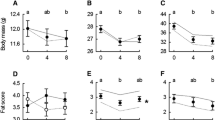Abstract
Rates of oxygen consumption and carbon dioxide release were measured in calling and resting European tree frogs using open-flow-through respirometry. The energetic cost of calling was high with an average of 1.076 ml O2/(g · h) at average call rates of 8000 calls/h. The maximum factorial metabolic scopes averaged 24 with momentary peak values ranging between 5 and 41. There was a threefold difference in O2-consumption between individual males calling at the same rate. Respiratory quotients indicated that both lipids and carbohydrates were used to fuel calling. Carbohydrates provided the major fuel (69% on average) with dependence on carbohydrates increasing with call rate. In contrast to marathon runners, there was no shift in metabolic substrate use over a calling period of 2–3 h.
Similar content being viewed by others
Author information
Authors and Affiliations
Additional information
Accepted: 25 September 2000
Rights and permissions
About this article
Cite this article
Grafe, T., Thein, J. Energetics of calling and metabolic substrate use during prolonged exercise in the European treefrog Hyla arborea. J Comp Physiol B 171, 69–76 (2001). https://doi.org/10.1007/s003600000151
Issue Date:
DOI: https://doi.org/10.1007/s003600000151




